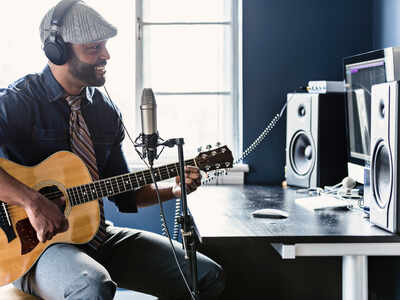Trending
This story is from October 31, 2020
The trend of investing in home recording setup reaches a crescendo
As the demand for online audio content increases, voice artistes are investing in home recording setup


There’s demand for voice artistes with at-home recording gear
As gigs completely came to a halt, Abraham Varghese aka Abe, a Bengaluru-based singer decided to build his voice-over portfolio. As he has been doing voice-over work on the sides of his music commitments, he had contacts. But the question was how he would get the work done as studios were shut. “Till the lockdown, I had only been in front of the mic. So, I didn’t really know what happened behind the mic. But it’s only during the lockdown that I realised the need to understand that.” Once that realisation sunk in, he decided to set up his own studio. “It took me a month to set it up properly. And I have been getting a hang of the technicalities in using them by going through online tutorials. The setup is pretty helpful as the turnaround time of getting things done is much faster,” says Abe, adding, “There’s an increasing demand for online content like audio books and e learning material, which require voice-over artistes.”
Another voice artiste, Shruti K from Chennai, says many clients are okay with artistes recording at home, provided the quality of the sound is not compromised. “Some clients specifically ask what kind of recording setup we’ve at home. If they’re happy about it, they give a go ahead to record at home. In fact, my sister, Smruthi K, recently dubbed for Trisha in Gautham Menon's short film, 'Karthik Dial Seytha Yenna', and I engineered the audio for that using the home recording setup.” Sean Bout, a Chennai based audio engineer, agrees with Shruti, saying he’s now comfortable giving artistes work to do from home as many of them have got at least basic recording setup ready. “I had this issue mainly with dialogue artistes, who recorded on their phone. So, I put out a few videos, encouraging them to invest in some basic home recording gear. And many of them did and work is much smoother now,” shares Sean, who has been doing an online series called ‘Tech Talk with Sean’ on recording basics, since the start of the lockdown. ,
Demand for entry-level recording equipment is high, say experts
Sudhin Prabhakar, the proprietor of a popular music store in Chennai, puts it this way, saying, “The sale of the entry-level recording kits have shot through the roof since March. Thanks to many amateur singers who are investing in it. We’ve been seeing tremendous growth in demand for everything from sound cards to headphones and microphones, which are required to make music production at home possible. We supply recording kits at different price ranges. Everything you need for recording comes in a kit. And they are moving fast. These are kits that start from a couple of thousand rupees and upwards. There are also a sizable number of professional artistes, who have never invested in a home recording setup, investing in it now. This apart, a lot of music students, too, are buying in order to enhance the productivity of their online classes.” John Sterrett, who owns a sound company in Bangalore, echoes Sudhin’s thoughts and says, “There’s been a definite increase in demand for microphones and interface.” And he adds that a complete home studio setup requires much more. “That would be a good investment, provided you have your own place. It requires a certain amount of permanent modification to treat the room acoustically,” he says.
Buy equipment after looking into different factors, say audio experts
This is what Nithin D'nello, a Chennai-based audio engineer, tries to educate artistes about. “It’s a 10-hour course that I do for them to make them understand what gear will be suitable for them and how to use them when they get it. For instance, a microphone needs to be picked up based on the acoustics of the room and the noise ambience around it. There are different factors that need to be looked in to before buying the equipment. I’ve so far had more than 100 people for this course in the last four to five months.”
Independent singer Alvin Presley, who came out with an EP completely produced in a home setup, says that when lockdown happened, he decided to invest in a few things that helped him produce near studio quality sound. “Apart from guitars, which I recorded in a studio before the pandemic, everything else from vocal recording to post production was done at home. So, I turned around my makeshift recording setup into a better one by using some bass traps and wall panels to capture reflection and unnecessary distortion. These are all used to improve the acoustics of a room.”
Pic:iStock
End of Article
FOLLOW US ON SOCIAL MEDIA







